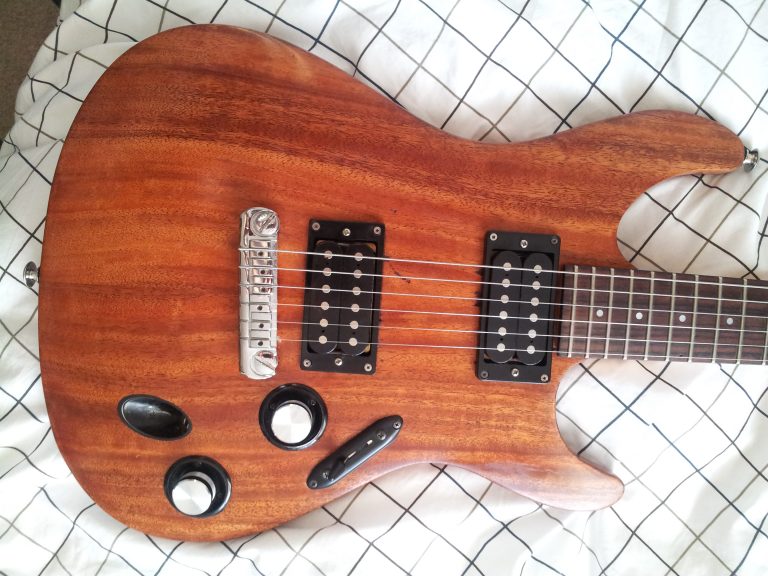Schecter Blackhawk BC-1
I’ve been looking for cheap guitars to modify for a while, so when a colleague mentioned he had an unused one stuffed under his bed I was straight onto it. Especially at the bargain price requested.

Visions of a beaten-up clunker went through my head, but upon opening the gig bag I saw a well-finished guitar that was in great condition apart from some manky old strings. There’s not much information availble about this model online, Schecter only seems to have produced a limited number and sold them for a short time, which seems to have mostly coincided with one of their gaps in UK distribution.
First impressions
Playing an electric guitar unplugged in the middle of an office is never a great way to start, but even through the heavily corroded strings I could tell that the neck was straight and true, the body was undamaged, and it seemed to be a decent guitar, although much heavier than other S-types I’ve played.
Once I got it home and gave it a thorough clean and set-up, it was time to plug it in – it played great and all the electrics worked. A bit of a bargain.
Build
That heavy body in high-gloss black is topped with a chrome tune-o-matic bridge and through-body stringing, with chrome ferrules on both the front and back. The gloss black finish is evenly applied, if a bit thick, but it certainly doesn’t look cheap. The maple neck’s unbound rosewood fingerboard and 24 chunky frets are finished to a good standard, and the scale is standard 25.5″.

Up at the headstock there’s a painted front, colour matched to the body, synthetic nut, and basic chrome 3-a-side tuners that work well.
Twin humbuckers in black plastic surrounds are controlled by a 3-way toggle, volume and tone, with the control knobs being surprisingly solid chromed metal, and the pots turning more smoothly and evenly than on many top of the range models.
Playability
In the hand, the neck profile feels wide and flat – there’s not much of a curve when you reach the 12th fret or so, making it feel like a block with the corners rounded off. There’s certainly no problem with playability from this, but I did find it quite tiring to play higher frets – perhaps because I like to anchor my thumb over the top of the neck. If your playing style is different then it may suit you better.

The twin cutaways are deep enough that reaching all 24 frets isn’t a struggle, and the extra string length behind the bridge gives a nicely balanced tension – it’s easy to bend a note up by 2 whole tones, but heavy-handing chording won’t be rewarded.
I used it for an hour on a wide leather strap at band practice – then had to swap to my RG due to my left arm going numb. I am reliably informed that this is due to me being “a big girl”, so if you’re used to heavy guitars then this will be right up your street.
Sounds
This is a seriously solid guitar. By solid I mean HEAVY. Combined with the through-body stringing, that gives it an incredible acoustic ring, loud enough that I’ve used it for recording ideas directly into my iPhone’s mic.

The stock Schecter pickups are high-output ceramic models, easily overdriving the clean channel on my Tubemeister, and would probably give DiMarzio Evolutions a run for their money on volume. Tone-wise they’re a bit bland and characterless at home volume levels, but cranked up in a band situation they perform quite well and make Zakk Wylde pinch harmonics into child’s play.
Normally on dual humbucker guitars I swap between the bridge and neck pickups, bypassing the middle position, but on the Blackhawk I found myself using all three positions a lot – the warmth of the neck mixed with the higher output punch of the bridge blended really well. Using volume and tone to alter the sound works well, the volume does need to be backed off a lot to really clean up, but playing with the tone control gives a wide range of usable options.
Final thoughts

For a guitar I was initially planning to strip down and rebuild, the Blackhawk BC-1 surprised me with its quality. It’s not my perfect guitar, but as an alternative to the standard superstrat clones it’s more than good enough to hold its own. Now I’ve got it I find myself happy to keep the stock looks, but I’ve been researching replacement pickups to find some with more character and a more controllable output level.
They’re uncommon, but if you find one of these for sale by chance then definitely give it a go – you might be surprised, and you might end up with a bargain.




